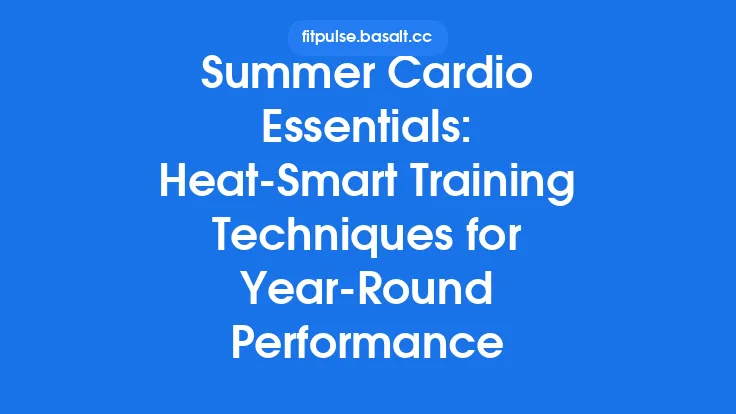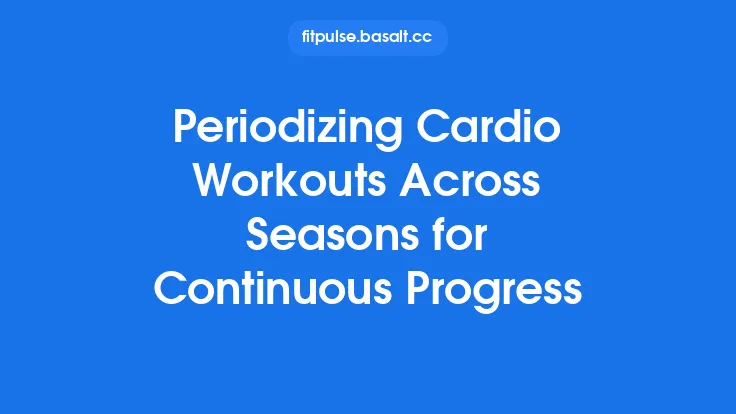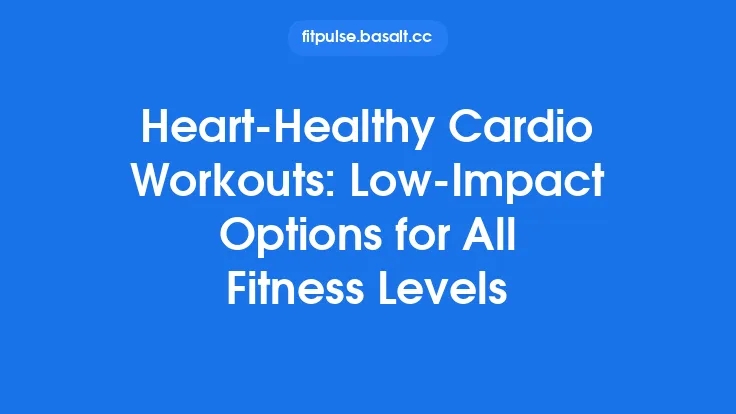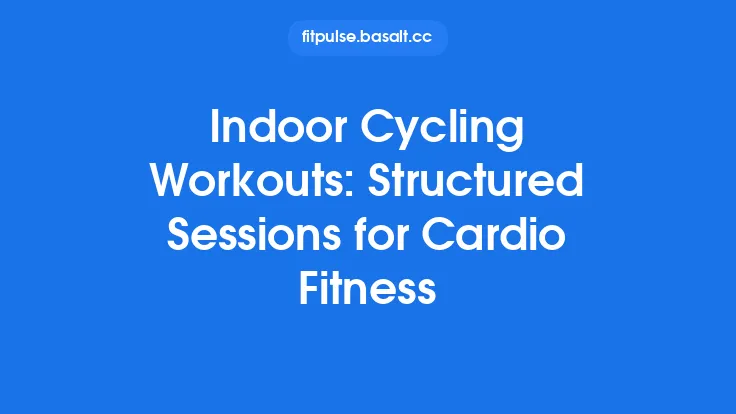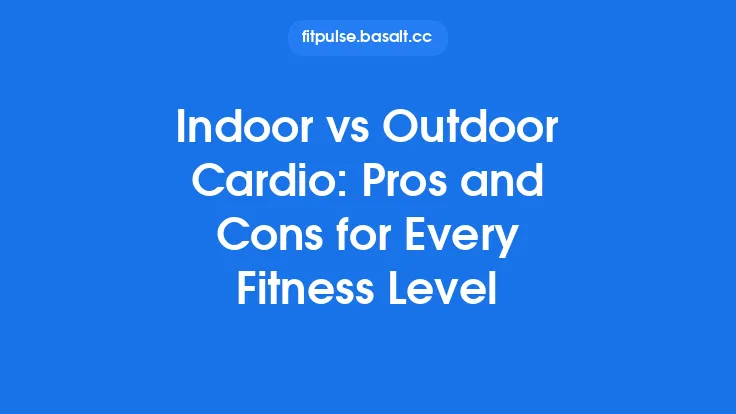Summer cardio workouts can feel especially demanding when the temperature climbs and humidity rises. While many athletes simply “tough it out,” a systematic approach to heat acclimation can transform those sweltering sessions into sustainable, high‑quality training opportunities. Below is a comprehensive, evergreen guide to heat‑acclimation protocols that will help you condition your cardiovascular system, improve thermoregulatory efficiency, and preserve performance throughout the hottest months.
Understanding Heat Acclimation: Physiological Foundations
Heat acclimation (HA) is the collection of adaptive responses that occur when the body is repeatedly exposed to elevated ambient temperatures while exercising. The primary goal of HA is to improve the balance between heat production (from muscular work) and heat dissipation (through skin blood flow, sweating, and respiratory evaporation). The most relevant physiological changes include:
| Adaptation | Mechanism | Performance Impact |
|---|---|---|
| Plasma Volume Expansion | ↑ Aldosterone‑mediated sodium and water retention → ↑ circulating blood volume | Improves stroke volume, reduces heart‑rate drift, and delays cardiovascular fatigue. |
| Increased Sweat Rate & Earlier Onset | Up‑regulation of eccrine gland activity | Enhances evaporative cooling, allowing core temperature to rise more slowly. |
| Reduced Sweat Sodium Concentration | Greater reabsorption of Na⁺ in sweat ducts | Conserves electrolytes, lessening the risk of hyponatremia during prolonged sessions. |
| Elevated Skin Blood Flow | Enhanced vasodilation via nitric‑oxide pathways | Improves heat transfer from core to skin surface. |
| Lower Core Temperature Set‑Point | Central thermoregulatory adjustments in the hypothalamus | Delays the point at which core temperature triggers performance‑limiting fatigue. |
| Improved Perceived Exertion | Neuromuscular adaptations and better thermal comfort | Allows athletes to maintain target paces with lower RPE (Rating of Perceived Exertion). |
These adaptations typically begin within 3–5 days of consistent heat exposure and reach near‑maximal levels after 10–14 days, though individual timelines can vary based on fitness, age, and prior heat experience.
Key Benefits for Summer Cardio Performance
- Stabilized Heart‑Rate Response – A larger plasma volume means the heart can pump more blood per beat, keeping heart‑rate elevation modest even as intensity rises.
- Extended Time‑to‑Exhaustion – Slower core temperature rise postpones the onset of heat‑induced fatigue, allowing longer runs, rides, or swims.
- Improved Lactate Clearance – Enhanced skin perfusion supports better removal of metabolic by‑products, indirectly supporting higher aerobic thresholds.
- Reduced Perceived Heat Stress – Athletes report feeling “cooler” and more comfortable, which translates into better pacing decisions and mental resilience.
Designing a Structured Heat Acclimation Program
A successful HA protocol blends controlled environmental exposure with progressive cardio workload. Below is a step‑by‑step framework that can be adapted to runners, cyclists, rowers, or any endurance discipline.
| Phase | Duration | Ambient Conditions* | Session Structure | Target Intensity |
|---|---|---|---|---|
| Baseline | 3–5 days | 20–22 °C, 40–50 % RH | Normal training (no heat) | Usual aerobic zones |
| Initial Acclimation | 5–7 days | 28–30 °C, 50–60 % RH | 30 min cardio + 10 min passive heat (e.g., sauna) | 60–70 % HRmax |
| Progressive Load | 7–10 days | 30–33 °C, 60–70 % RH | 45–60 min cardio, split into 2–3 intervals with 5 min low‑intensity recovery | 70–80 % HRmax |
| Peak Acclimation | 5–7 days | 33–35 °C, 70–80 % RH | 60–90 min cardio, continuous or long intervals; include one “simulation” run at target race pace | 80–85 % HRmax |
| Maintenance | Ongoing (1–2 × week) | 30–33 °C, 60–70 % RH | 45 min cardio, moderate intensity | 70–80 % HRmax |
\*If outdoor conditions are not reliably within the target range, use a climate‑controlled chamber, portable heat tents, or a sauna combined with a short cardio bout to achieve the desired thermal load.
Key principles
- Gradual Increment – Increase either temperature, duration, or intensity by no more than 10 % per session to avoid excessive cardiovascular drift.
- Consistent Frequency – Aim for 4–5 HA sessions per week; skipping more than 48 h can slow adaptation.
- Recovery Emphasis – Include at least one full rest day or a low‑intensity active recovery session (e.g., easy spin) to allow plasma volume consolidation.
Progressive Exposure Strategies
1. Active Heat Exposure (Exercise in Warm Conditions)
- Best for: Athletes who can train outdoors or have access to a heated indoor track.
- Implementation: Begin with low‑intensity steady‑state work; gradually introduce tempo intervals as tolerance builds.
2. Passive Heat Exposure (Sauna, Hot Water Immersion)
- Best for: Situations where outdoor heat is unavailable or when you need to separate cardio load from thermal stress.
- Implementation: After a standard cardio session, sit in a sauna (80–90 °C) for 10–15 min, or immerse the lower body in 38–40 °C water for 20 min.
3. Hybrid Approach
- Combine a moderate‑intensity run (30 min) with a post‑run sauna session (10 min). This method maximizes cardiovascular stimulus while still delivering a robust thermal load.
4. Heat‑Chamber Training
- For elite or highly data‑driven athletes, a climate chamber allows precise control over temperature, humidity, and airflow. Use programmable protocols that mimic race‑day heat profiles (e.g., 35 °C, 70 % RH for a 10 km run).
Monitoring and Adjusting Training Load
Effective HA hinges on objective data to ensure adaptations are occurring without crossing into heat‑related illness. The following metrics are most informative:
| Metric | Tool | Target Range (During Acclimation) |
|---|---|---|
| Core Temperature | Ingestible telemetry pill, ear‑probe, or rectal sensor | ≤ 38.5 °C for most sessions; occasional peaks up to 39 °C are acceptable if brief. |
| Heart Rate (HR) | Chest strap or optical HR monitor | HR drift ≤ 10 bpm over a 30‑min steady‑state effort. |
| Rate of Perceived Exertion (RPE) | Borg 6–20 scale | RPE should not exceed 13–14 during moderate sessions; if it spikes, reduce intensity or duration. |
| Sweat Rate | Pre‑ and post‑session body mass (minus fluid intake) | Aim for 0.8–1.2 L h⁻¹; large deviations may indicate inadequate plasma expansion. |
| Blood Pressure | Automated cuff (optional) | Systolic should remain ≤ 140 mmHg during exercise; large spikes suggest over‑stress. |
Adjustment Guidelines
- If core temperature rises > 39 °C → Reduce ambient temperature by 2–3 °C or cut session length by 10–15 %.
- If HR drift exceeds 10 bpm → Lower intensity or increase rest intervals.
- If RPE climbs > 2 points from baseline → Re‑evaluate hydration, sleep, and overall training load.
Integrating Acclimation with Regular Cardio Sessions
Heat acclimation should complement, not replace, your core cardio program. Here’s how to weave HA into a typical weekly schedule:
| Day | Session Type | Focus |
|---|---|---|
| Mon | Moderate‑intensity run (30 min) in ambient heat | Active HA – low intensity |
| Tue | Easy bike ride (45 min) in temperate conditions | Recovery, maintain aerobic base |
| Wed | Interval run (4 × 5 min at tempo) + post‑run sauna (10 min) | Hybrid HA – higher intensity |
| Thu | Rest or light mobility work | Consolidation of plasma volume |
| Fri | Long run (60 min) at target race pace in heat chamber | Peak HA – performance simulation |
| Sat | Cross‑training (swim or elliptical) in cool environment | Reduce cumulative heat load |
| Sun | Active recovery (walk or yoga) | General recovery |
By alternating heat‑focused days with cooler, lower‑stress sessions, you preserve the quality of your overall cardio development while still driving HA adaptations.
Maintaining Acclimation Over the Season
Once you have achieved a satisfactory level of heat adaptation, the goal shifts to maintenance. Research shows that plasma volume and sweat adaptations can regress after 7–10 days of cool‑weather training. To sustain HA:
- Weekly “Heat Boost” – Schedule at least one 45‑minute cardio session in warm conditions every 7–10 days.
- Periodic Sauna Sessions – Two 15‑minute sauna exposures per week can preserve plasma volume without additional cardio stress.
- Travel Acclimation – If you travel to a cooler climate for a race, begin a short HA block (3–4 days) 5 km before departure to minimize de‑acclimation.
Common Pitfalls and How to Avoid Them
| Pitfall | Why It Happens | Prevention |
|---|---|---|
| Excessive Heat Load Too Quickly | Over‑ambitious temperature or duration increase. | Follow the 10 % rule for any single variable (temp, time, intensity). |
| Neglecting Core Temperature Monitoring | Assumes “feeling hot” equals safe. | Use a reliable core‑temp sensor for the first two weeks of HA. |
| Skipping Recovery Days | Belief that “more heat = faster adaptation.” | Schedule at least one full rest day per week; incorporate low‑intensity active recovery. |
| Relying Solely on Perceived Exertion | RPE can be blunted after several sessions. | Pair RPE with objective HR and core‑temp data. |
| Ignoring Individual Variability | One‑size‑fits‑all protocols. | Adjust based on age, fitness level, and prior heat exposure; older athletes may need longer acclimation periods. |
Practical Tools and Resources
- Heat‑Stress Apps – Many smartphone platforms integrate ambient temperature, humidity, and WBGT (Wet‑Bulb Globe Temperature) calculations to help you select safe training windows.
- Wearable Core‑Temp Sensors – Devices such as the CoreTemp ingestible pill or the TempTraq ear sensor provide real‑time data without invasive procedures.
- Portable Sauna Tents – Compact, electric tents can generate 80–90 °C environments for post‑workout passive exposure.
- Climate‑Controlled Gyms – Some urban fitness centers now feature temperature‑regulated rooms; inquire about hourly rates for dedicated HA sessions.
- Scientific Literature – Key papers include:
- Sawka et al., 2015, “Thermoregulatory and Cardiovascular Adaptations to Heat Acclimation.”
- Racinais et al., 2017, “Heat Acclimation Protocols for Endurance Athletes.”
These resources can help you fine‑tune your protocol, track progress, and stay aligned with the latest evidence.
Bottom line: Heat acclimation is a science‑backed, systematic process that transforms the challenge of summer heat into a performance advantage. By understanding the underlying physiology, following a progressive exposure plan, monitoring key metrics, and integrating HA intelligently with your broader cardio regimen, you can sustain high‑quality workouts throughout the hottest months—without sacrificing health or long‑term progress. Embrace the heat, train smart, and let your cardiovascular system adapt to thrive when the temperature rises.

